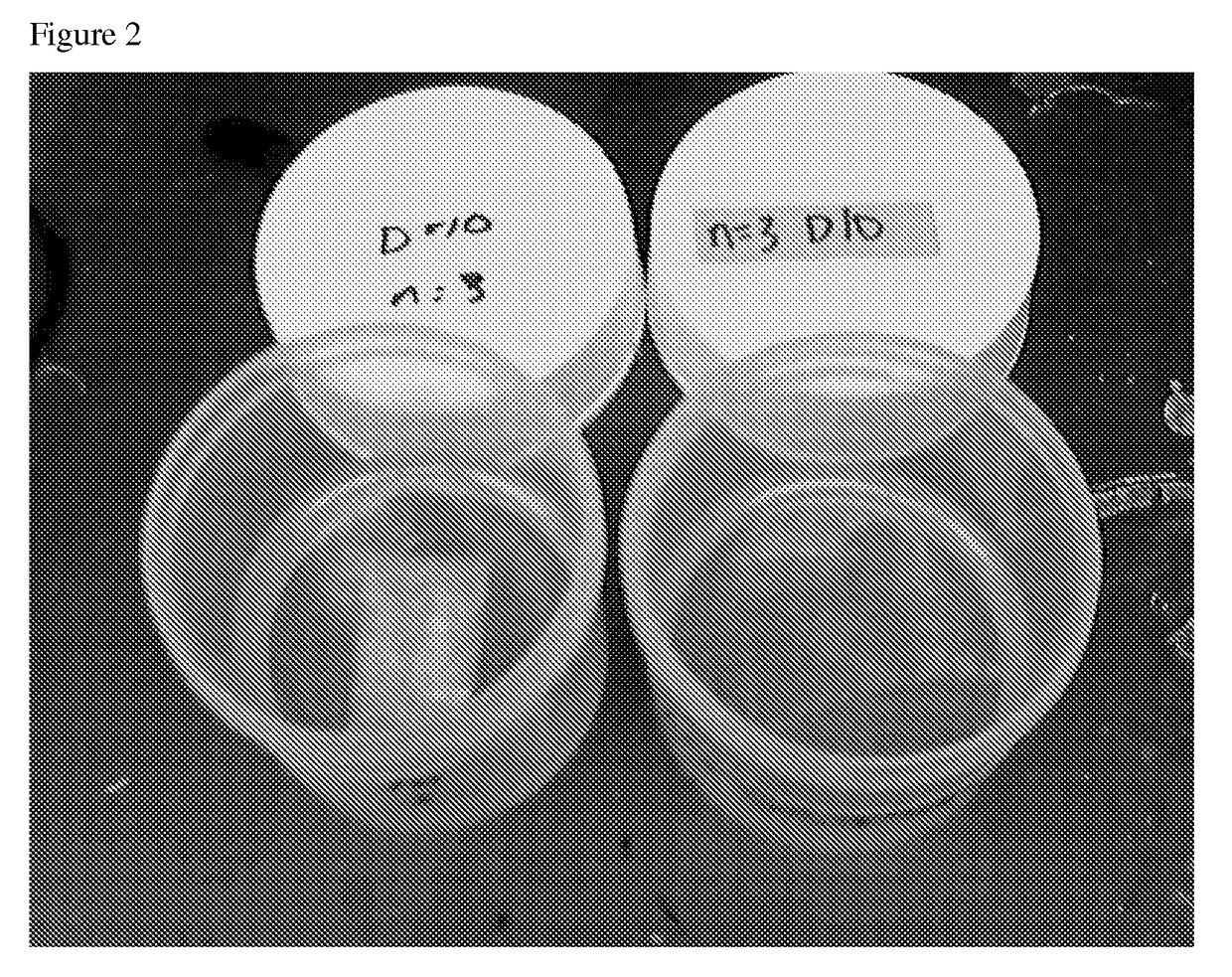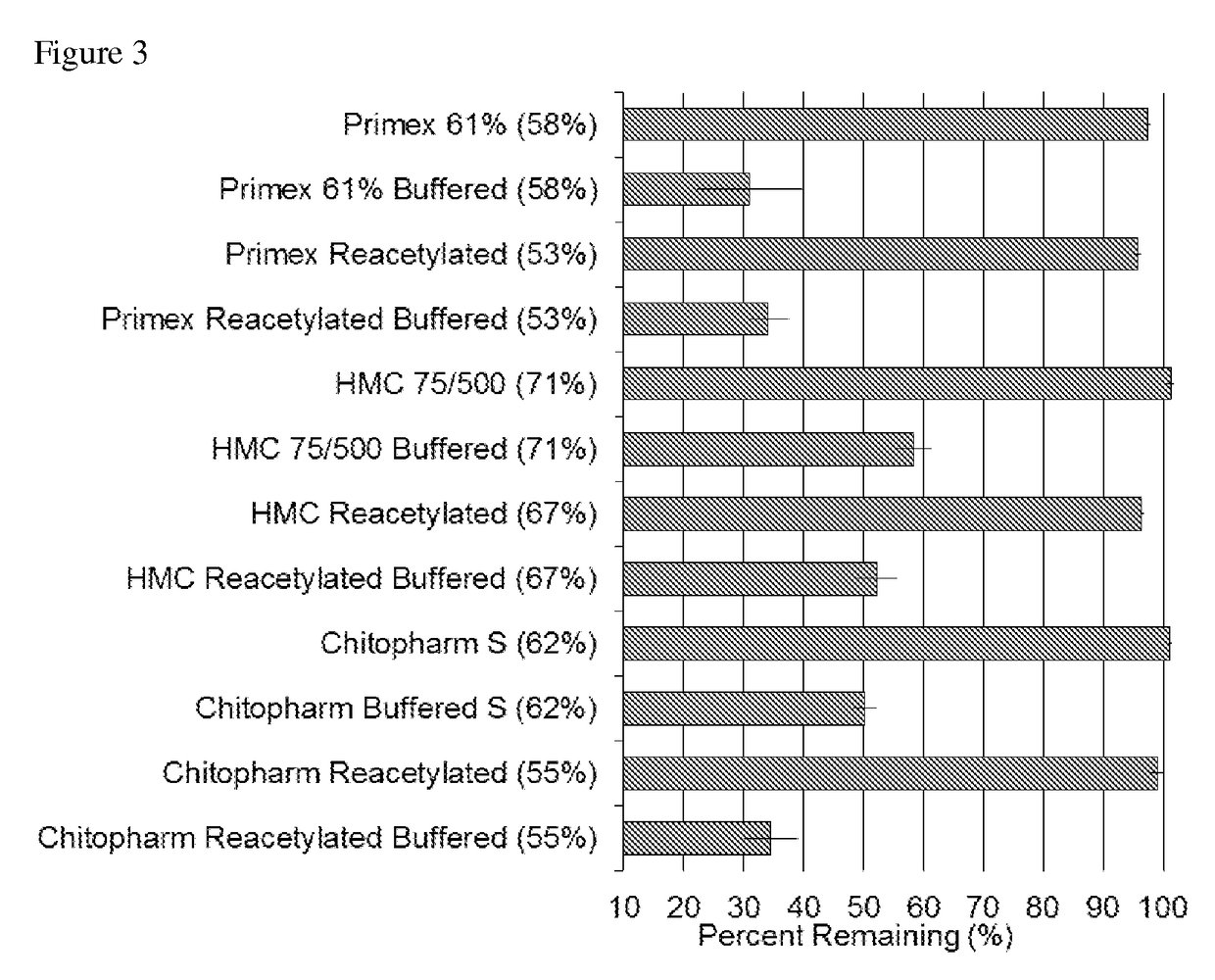Methods for producing a biodegradable chitosan composition and uses thereof
a biodegradable, composition technology, applied in the direction of prosthesis, suture equipment, peptide/protein ingredients, etc., can solve the problems of pathogen entry and infection, complex open wounds, and prone to infection of bone and associated tissues, so as to reduce the probability of developing a disorder
- Summary
- Abstract
- Description
- Claims
- Application Information
AI Technical Summary
Benefits of technology
Problems solved by technology
Method used
Image
Examples
example 1
Preparation of Chitosan Sponges
[0126]Chitosan sponges are prepared using the following steps:[0127](1) Dissolve chitosan in a weak organic acid aqueous solution.[0128](2) Freeze the resulting chitosan and acid solution.[0129](3) Lyophilize the frozen, solid chitosan solution, removing the water.[0130](4) Completely neutralize the resulting dehydrated, acidic chitosan “sponge” by hydrating it in an excess concentration and volume of sodium hydroxide aqueous solution. (See FIG. 1)[0131](5) Wash away the residual acidic and basic products using a copious amount ultrapure water.[0132](6) Buffer the hydrated, neutral chitosan sponge by soaking it in a 0.25M acetate buffer solution at pH 5.6 for thirty minutes.[0133](7) Remove excess liquid from the sponge.[0134](8) Freeze the resulting hydrated, buffered chitosan sponge.[0135](9) Lyophilize the frozen, solid chitosan sponge, removing the water.[0136](10) Store the finalized, buffered chitosan sponge product in a low humidity environment....
example 2
Buffered Sponges Degrade More Completely than Unbuffered Sponges
[0141]As shown in FIGS. 2 and 3, chitosan sponge's that were buffered had a significantly increased degree of degradation profile.
[0142]Sponges that have undergone a buffering step degraded more completely than unbuffered sponges. This is advantageous because as a drug delivery device for wound infection prevention or therapy, the chitosan sponge is desired to degrade away after its drug delivery task is complete (usually in 4 to 10 days). Desirably, degradation in this time frame makes a secondary, device retrieval surgery unnecessary. By eliminating residual sponge material, more complete degradation also obviates the possibility that the undegraded sponge will become a site for future infection. Thus, the buffer step solves the challenge of manufacturing a reproducibly and uniformly degradable chitosan sponge. Additionally, it allows for the degradation process to be controlled by manipulating the acid buffer type, b...
example 3
Preparation of a Chitosan Composite
[0145]A composite containing chitosan sponge in chitosan gel (a “sponge-in-gel” composite) can be made from a chitosan gel component and a chitosan sponge component made as described above. A gel “matrix” component is prepared by dissolving chitosan (e.g., as described herein), filtering particulate, and allowing the solution to de-gas overnight. Chitosan solution is transferred into a container and frozen for at least 1 hour (−80° C.). The length of time the chitosan solution is frozen can be altered. After freezing, the frozen samples are lyophilized for ˜48 hours and sterilized via gamma irradiation. This chitosan component is not neutralized and is used as the adhesive “gel” matrix.
[0146]A “sponge” component is prepared using the lyophilized sponges (e.g., as described herein). The lyophilized sponges are neutralized by submerging in sodium hydroxide solution (various concentrations of NaOH may be used). Hydrated sponges are rinsed with water s...
PUM
| Property | Measurement | Unit |
|---|---|---|
| time | aaaaa | aaaaa |
| time | aaaaa | aaaaa |
| time | aaaaa | aaaaa |
Abstract
Description
Claims
Application Information
 Login to View More
Login to View More - R&D
- Intellectual Property
- Life Sciences
- Materials
- Tech Scout
- Unparalleled Data Quality
- Higher Quality Content
- 60% Fewer Hallucinations
Browse by: Latest US Patents, China's latest patents, Technical Efficacy Thesaurus, Application Domain, Technology Topic, Popular Technical Reports.
© 2025 PatSnap. All rights reserved.Legal|Privacy policy|Modern Slavery Act Transparency Statement|Sitemap|About US| Contact US: help@patsnap.com



